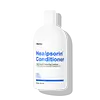What's inside
What's inside
 Key Ingredients
Key Ingredients

No key ingredients
 Benefits
Benefits

 Concerns
Concerns

 Ingredients Side-by-side
Ingredients Side-by-side

Water
Skin ConditioningPanthenol
Skin ConditioningBehentrimonium Chloride
PreservativeCetearyl Alcohol
EmollientCamellia Kissi Seed Oil
EmollientPentaclethra Macroloba Seed Oil
EmollientButyrospermum Parkii Butter
Skin ConditioningCocos Nucifera Oil
MaskingLactobacillus
Skin ConditioningLactobacillus Ferment
Skin ConditioningOlea Europaea Fruit Oil
MaskingRicinus Communis Seed Oil
MaskingPropylene Glycol
HumectantSodium PCA
HumectantSodium Lactate
BufferingArginine
MaskingAspartic Acid
MaskingPCA
HumectantGlycine
BufferingAlanine
MaskingSerine
MaskingValine
MaskingProline
Skin ConditioningThreonine
Isoleucine
Skin ConditioningHistidine
HumectantPhenylalanine
MaskingSodium Caproyl/Lauroyl Lactylate
AntimicrobialTriethyl Citrate
MaskingPhenoxyethanol
PreservativeEthylhexylglycerin
Skin ConditioningParfum
MaskingWater, Panthenol, Behentrimonium Chloride, Cetearyl Alcohol, Camellia Kissi Seed Oil, Pentaclethra Macroloba Seed Oil, Butyrospermum Parkii Butter, Cocos Nucifera Oil, Lactobacillus, Lactobacillus Ferment, Olea Europaea Fruit Oil, Ricinus Communis Seed Oil, Propylene Glycol, Sodium PCA, Sodium Lactate, Arginine, Aspartic Acid, PCA, Glycine, Alanine, Serine, Valine, Proline, Threonine, Isoleucine, Histidine, Phenylalanine, Sodium Caproyl/Lauroyl Lactylate, Triethyl Citrate, Phenoxyethanol, Ethylhexylglycerin, Parfum
Water
Skin ConditioningStearyl Alcohol
EmollientBehentrimonium Chloride
PreservativeCetyl Alcohol
EmollientIsopropyl Alcohol
SolventBis-Aminopropyl Dimethicone
Phenoxyethanol
PreservativeBenzyl Alcohol
PerfumingParfum
MaskingSodium Benzoate
MaskingPiroctone Olamine
PreservativeCitric Acid
BufferingTocopheryl Acetate
AntioxidantMenthol
MaskingHexyl Cinnamal
PerfumingNiacinamide
SmoothingAloe Barbadensis Leaf Juice
Skin ConditioningPolysorbate 20
EmulsifyingLinalool
PerfumingHydroxycitronellal
PerfumingGeraniol
PerfumingWater, Stearyl Alcohol, Behentrimonium Chloride, Cetyl Alcohol, Isopropyl Alcohol, Bis-Aminopropyl Dimethicone, Phenoxyethanol, Benzyl Alcohol, Parfum, Sodium Benzoate, Piroctone Olamine, Citric Acid, Tocopheryl Acetate, Menthol, Hexyl Cinnamal, Niacinamide, Aloe Barbadensis Leaf Juice, Polysorbate 20, Linalool, Hydroxycitronellal, Geraniol
Ingredients Explained
These ingredients are found in both products.
Ingredients higher up in an ingredient list are typically present in a larger amount.
This ingredient is a preservative and often used for it's anti-static properties. You'll most likely see this ingredient in hair conditioners.
It does not cause irritation or sensitization in leave-on products at 1-5%.
Parfum is a catch-all term for an ingredient or more that is used to give a scent to products.
Also called "fragrance", this ingredient can be a blend of hundreds of chemicals or plant oils. This means every product with "fragrance" or "parfum" in the ingredients list is a different mixture.
For instance, Habanolide is a proprietary trade name for a specific aroma chemical. When used as a fragrance ingredient in cosmetics, most aroma chemicals fall under the broad labeling category of “FRAGRANCE” or “PARFUM” according to EU and US regulations.
The term 'parfum' or 'fragrance' is not regulated in many countries. In many cases, it is up to the brand to define this term.
For instance, many brands choose to label themselves as "fragrance-free" because they are not using synthetic fragrances. However, their products may still contain ingredients such as essential oils that are considered a fragrance by INCI standards.
One example is Calendula flower extract. Calendula is an essential oil that still imparts a scent or 'fragrance'.
Depending on the blend, the ingredients in the mixture can cause allergies and sensitivities on the skin. Some ingredients that are known EU allergens include linalool and citronellol.
Parfum can also be used to mask or cover an unpleasant scent.
The bottom line is: not all fragrances/parfum/ingredients are created equally. If you are worried about fragrances, we recommend taking a closer look at an ingredient. And of course, we always recommend speaking with a professional.
Learn more about ParfumPhenoxyethanol is a preservative that has germicide, antimicrobial, and aromatic properties. Studies show that phenoxyethanol can prevent microbial growth. By itself, it has a scent that is similar to that of a rose.
It's often used in formulations along with Caprylyl Glycol to preserve the shelf life of products.
Water. It's the most common cosmetic ingredient of all. You'll usually see it at the top of ingredient lists, meaning that it makes up the largest part of the product.
So why is it so popular? Water most often acts as a solvent - this means that it helps dissolve other ingredients into the formulation.
You'll also recognize water as that liquid we all need to stay alive. If you see this, drink a glass of water. Stay hydrated!
Learn more about Water